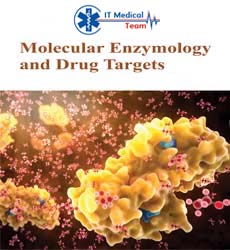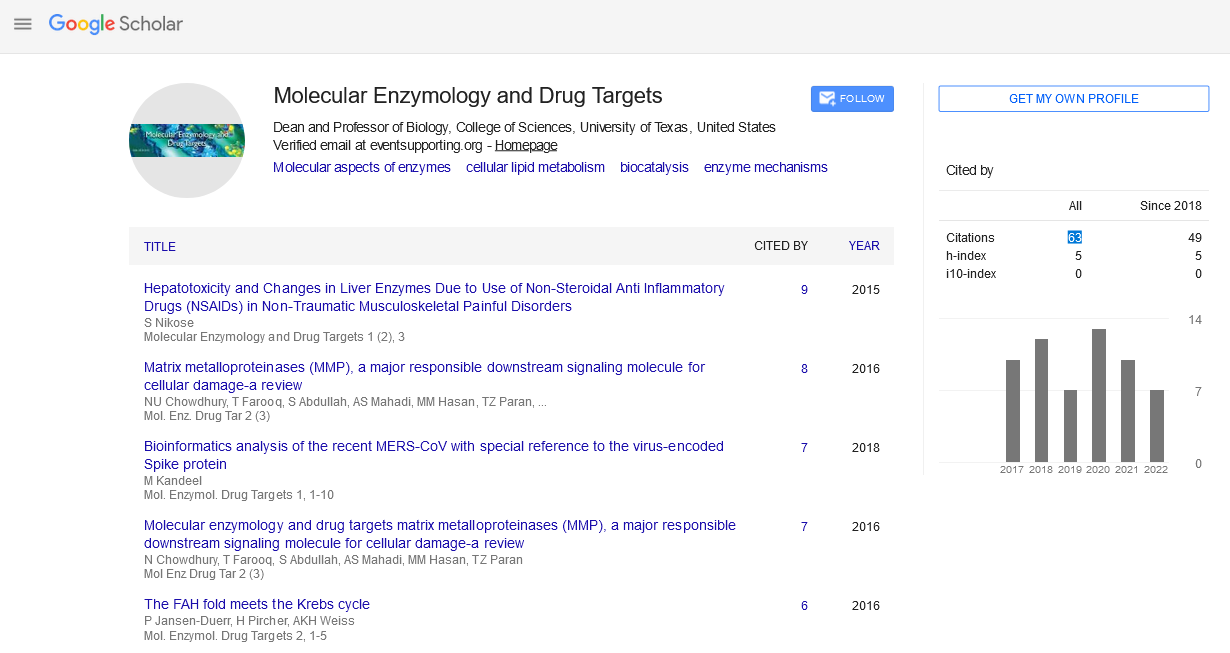Mini Review - (2022) Volume 8, Issue 6
A Short Note on Molecular Drug
Targets and its Types
Iysha Mariyam*
Department of Molecular Biology and Biochemistry, University of California, Irvine Irvine, CA 92697-2025, USA
*Correspondence:
Iysha Mariyam, Department of Molecular Biology and Biochemistry, University of California, Irvine Irvine, CA 92697-2025,
USA,
Email:
Received: 01-Dec-2022, Manuscript No. Ipmedt-22-13337;
Editor assigned: 05-Dec-2022, Pre QC No. Ipmedt-22-13337;
Reviewed: 19-Dec-2022, QC No. Ipmedt-22-13337;
Revised: 26-Dec-2022, Manuscript No. Ipmedt-22-13337;
Published:
30-Dec-2022, DOI: 2572-5475- 08.06-119
Abstract
The outcome of instrument put together medication revelation depends with respect to the meaning of the medication target. As we try to connect drug response to genetic variation, comprehend stratified clinical efficacy and safety, explain the differences between drugs in the same therapeutic class, and predict drug utility in patient subgroups, this definition takes on even greater significance. However, the literature frequently provides inadequate definitions of drug targets, both for currently being developed therapeutic agents and for drugs that have already been approved for use. An updated and comprehensive map of approved drugs' molecular targets is presented here. Information that can lead to an avalanche of therapeutic targets can be obtained through access to the complete sequences of pathogenic organisms and the human genome. One of the first methods used in drug design is structure-based design. Finding and enhancing the 3D structure (binding and/or active site) of a target molecule, such as a receptor protein, is specifically referred to as structure-based design. This review aims to provide an overview of studies in the field of structure-based drug design that have aided in drug discovery. Comparative and homology modeling will be the primary focus. We curate 893 biomolecules derived from humans and pathogens, which are used in 1,578 US FDA-approved drugs. These biomolecules include 667 proteins that are derived from the human genome and are the targets of drugs that treat human disease. The analysis of these drug targets reveals not only the expansion of novel first-in-class mechanisms, particularly in oncology, but also the continued dominance of privileged target families across disease areas. We investigate the presence of orthologues between human and animal models, as well as between pathogen and human genomes, as well as the connections between bioactivity class and clinical success. Through the cooperation of three autonomous groups, we feature a portion of the continuous difficulties in precisely characterizing the objectives of sub-atomic therapeutics and present shows for deconvoluting the intricacies of atomic pharmacology and medication viability.
Keywords
Drug targets; Protein modeling; Ligands; Design
INTRODUCTION
All small molecules and biologics that are currently approved (or
have previously been approved) by the US FDA (before June 2015)
to enhance human health, in addition to antimalarial drugs that
are approved elsewhere in the world, are included in this definition
of a "drug," which only includes therapeutic ingredients. Imaging
agents, nutritional supplements, sunscreens, and vaccines are not considered drugs [1]. In addition, the numbers presented in
the paper are for parent compounds after pharmaceutical salts
have been removed. Due to the variety of required information
sources and the number of different regulatory agencies involved,
it is extremely difficult to identify a complete set of drugs that
have been approved anywhere in the world. Additionally, the lack
of information presents a problem; For instance, the European
Medicines Agency does not have data on drug approvals prior
to 1995, and the Japan Pharmaceutical and Medical Devices Agency has only published lists of drug approvals in English since
2004 (see Additional information). However, we also identified
a group of more than 1,200 drugs that have been approved by
other agencies but have not yet been approved by the FDA [2].
The novel targets in this group are discussed separately. With the
discovery of the three-dimensional structures of globins, enzymes,
and polypeptide hormones, discussions of the application of
structural biology in drug discovery began more than 35 years
ago. The chemical modification of insulins to increase half-lives in
circulation, the design of inhibitors of serine proteases to control
blood clotting, and the use of 3D structures to guide the synthesis
of ligands of haemoglobin to decrease sickling or improve
blood storage were among the earliest ideas in circulation.
The UK Wellcome Foundation's 1975 program on haemoglobin
structures was an early and daring initiative. However, X-ray
crystallography required a lot of time and money. This method
could not be brought "in-house" into industrial laboratories,
and the pharmaceutical industry initially did not really embrace
it. Over time, drug design was informed by understanding the
3D structures of target proteins [3]. Comparative models based
on homologues began to be utilized in lead optimization in the
1980s, despite the fact that the relevant drug targets' structures
were rarely accessible directly from X-ray crystallography in
the early days. A model was the utilization of aspartic protease
designs to display renin, an objective for antihypertensive.
Types of drug targets
Drug Target
The development of genomics, proteomics, and metabolomics
has opened the door to biologically driven processes, which
has resulted in an abundance of drug targets. The rundown of
potential medication targets encoded in a genome incorporates
generally normal decision of destructive qualities and speciesexplicit
qualities [4].
Species-Specific Genes as Drug Targets
The first insights into the approaches that will be used in the near
future for drug discovery are provided by comparing the complete
genome sequences of bacterial pathogens that are available in
the public databases. Bork and colleagues have proposed the
differential genome display, an intriguing method for predicting
potential drug targets. The fact that parasitic microorganism
genomes are typically much smaller and encode for fewer
proteins than those of free-living organisms is the foundation of
this strategy. As a result, the genes that are found in the genome
of a parasitic bacterium but not in the genome of a free-living
bacterium are likely to be important for pathogenecity and could
be targets for drug [5, 6]
Nucleic Acid as Drug Targets
Nucleic acids are the repository of genetic information. DNA
itself has been shown to be the receptor for many drugs used in
cancer and other diseases [7]. These work through a variety of
mechanisms including chemical modification and cross linking of
DNA (cisplatin) or cleavage of the DNA (bleomycin). Much work
either by intercalation of a polyaromatic ring system into the double stranded helix (actinomycin D, ethidium) or by binding to
the major and minor grooves of DNA has been reported.
RNA as drug target
New opportunities that will have a significant impact on the
pharmaceutical industry have emerged as a result of recent
advancements in the investigation of RNA structure and function.
It was thought that RNA, which communicates with proteins and
DNA among other things, was a completely flexible molecule
with little structural complexity. However, recent research has
demonstrated a surprising complexity in the structure of RNA.
The pharmaceutical industry now has new opportunities to
target RNA with small molecules thanks to this observation. More
importantly, drugs that bind to RNA may have effects that drugs
that bind to proteins can't have [8, 9].
Membranes as drug targets
Membranes are important structural components because they
not only help define a cell's boundaries but also provide interior
compartments within the cell that are associated with particular
functions. Cell layers themselves can likewise go about as focuses
for atomic acknowledgment. Drug molecules with improved
permeation characteristics or specific membrane effects may
benefit from an understanding of the structural and dynamic
functions of membranes, such as plasma membranes and
intercellular membranes. When dissolved in membranes, many
general anesthetics are thought to work by their physical effects.
Proteins as drug targets
The pharmaceutical and biotechnology industries continue to
pay a lot of attention to proteins as a useful source of potential
drug targets. Proteins are the key to understanding fundamental
biological processes like disease pathology, diagnosis, and
treatment because they provide the crucial link between genes
and disease. Over 700 products are currently in various stages
of development, and researchers have discovered numerous
potential therapeutic targets. However, there are significant
obstacles in converting protein research into validated drug
targets. Genome arrangements teach cells on how and when to
make proteins. The cell's active players are, in turn, the proteins.
Proteins control an organism's growth or death, enable cells to
communicate with one another, and form the machinery of cells [10].
Conclusion
With a focus on the trends and shifts that have occurred over
the past ten years7, we have provided an enhanced and updated
perspective on the current diversity of approved drugs and
their targets in this article. It is not an easy task to compile a
comprehensive list of drug efficacy targets, but with the help
of three teams, we have demonstrated some of the practical
obstacles and made significant progress toward this objective.
These difficulties include determining the non-trivial relationship
between a drug target and a gene, assigning the target, and finally
establishing a method for counting final effective molecular
targets that takes into account complexes, subunits, splice
variants, and protein isoforms a major reason why the number of
protein targets increased to 667 from 324 in our previous study7.
Analyzing the variety of existing drugs and targets in light of their
disease coverage requires all of this. These annotations, on the
other hand, will need to be updated on a regular basis due to the
constant evolution of drug mechanism of action knowledge in the
literature.
As a result, research in biotechnology and pharmaceuticals
has undergone significant change. The industry's search for
new drug targets has traditionally been hampered by a lack of
biological data. Bioinformatics now offers a number of methods
for predicting the structure and function of proteins based on
similarities in sequence and structure thanks to the release of the
human genome's sequence. Rational drug design is now possible
thanks to impressive technological advancements in computer
science, molecular biology, and structural characterization of bio
macromolecules.
Acknowledgement
None
Conflict of Interest
None
References
- Roberts KE (2009) True single-port appendectomy: first experience with the puppeteer technique.Surg Endosc23: 1825-1830.
Indexed at, Google Scholar, Crossref
- Navarra G, Pozza E, Occhionorelli S, Carcoforo P (1997) One-wound laparoscopic cholecystectomy.Br J Surg84: 695.
Indexed at, Google Scholar, Crossref
- Remzi KH, Kirat HT, Kaouk JH, Geisler DP (2008) Single-port laparoscopy in colorectal surgery.ColorectalDis10: 823-826.
Indexed at, Google Scholar, Crossref
- Bucher P, Pugin F, Morel P (2008) Single port access laparoscopic right hemicolectomy.Int J ColorectalDis23: 1013-1016.
Indexed at, Google Scholar, Crossref
- Ohtani H, Tamamori Y, Nishiguchi Y, Maeda K, Hirakawa K, et al. (2012) Meta-analysis of the results of randomized controlled trials that compared laparoscopic and open surgery for acute appendicitis.JGastrointest Surg 16: 1929-1939.
Indexed at, Google Scholar, Crossref
- Ruetsch YA, Böni T, Borgeat A (2001) from cocaine to ropivacaine: the history of local anesthetic drugs. Curr Top Med Chem 1: 175-82.
Indexed at, Google Scholar, Crossref
- Mallinson T (2019) Fascia iliaca compartment block: a short how-to guide. J Paramed Pract 11: 154-55.
Google Scholar, Crossref
- Ullah H, Samad K, Khan FA (2014) Continuous interscalene brachial plexus block versus parenteral analgesia for postoperative pain relief after major shoulder surgery. CDSR (2): 7080.
Indexed at, Google Scholar, Crossref
- Radvansky BM, Shah K, Parikh A, Sifonios AN, Eloy JD, et al. (2015) Role of ketamine in acute postoperative pain management: a narrative review. BioMed Research International.
Indexed at, Google Scholar, Crossref
- Pahor AL (1992) Ear, nose and throat in ancient Egypt. J Lar Otol Lond 106: 677-87.
Indexed at, Google Scholar, Crossref
Citation: Mariyam I (2021) A Short Note on Molecular Drug Targets and its Types. Mol Enzy Drug Targ, Vol. 8 No. 6: 119.





